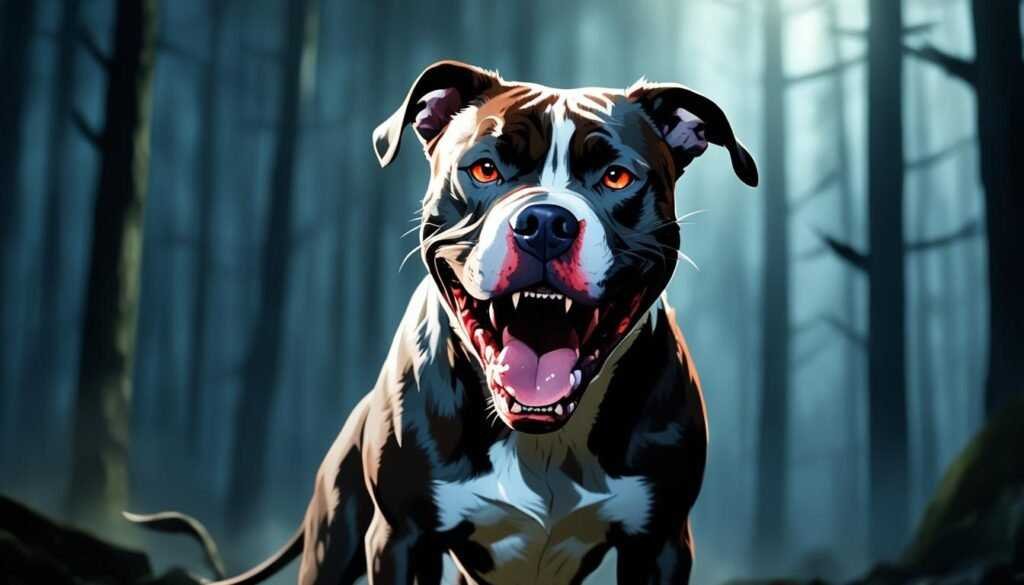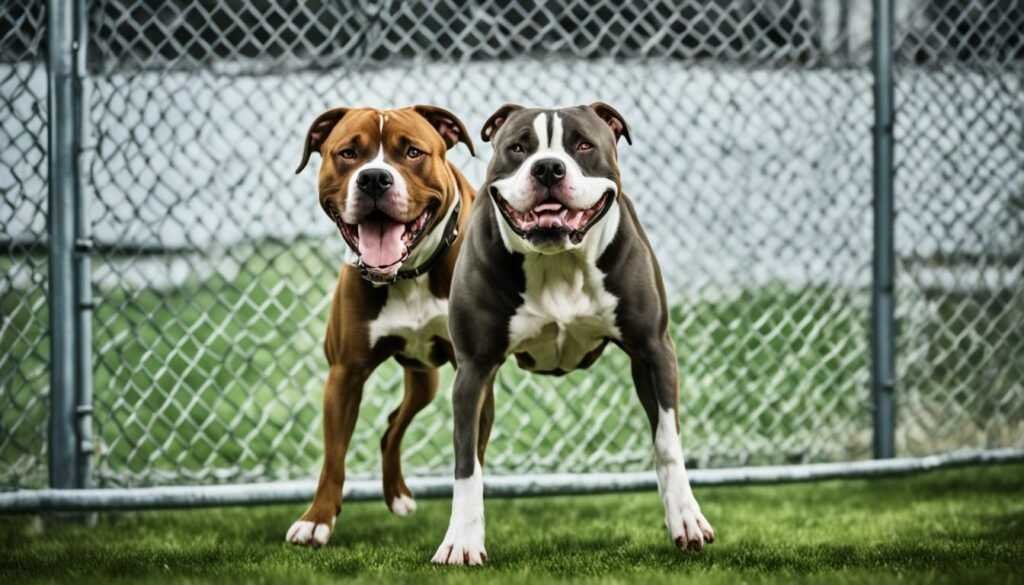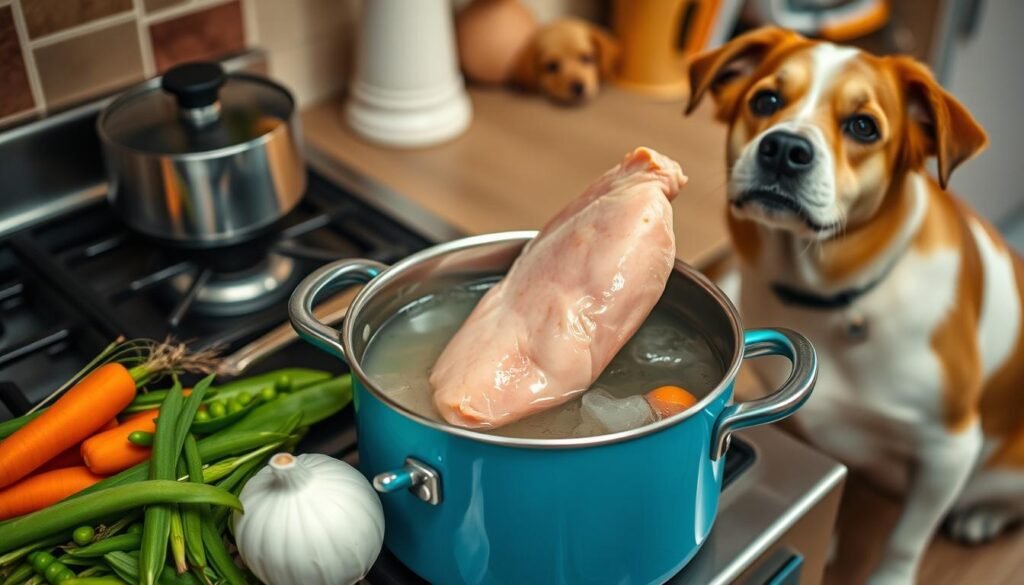- Understanding Pitbulls: Nature vs Nurture
- What Happens When a Pitbull Tastes Blood
- Pitbull Behavior After Tasting Blood
- Pitbull Aggression Triggers
- Pitbull Instincts with Blood
- Effects of a Pitbull Tasting Blood
- Conclusion
- FAQ
- What happens when a Pitbull tastes blood?
- Can tasting blood cause lasting aggression in Pitbulls?
- What are the physiological responses of a Pitbull upon tasting blood?
- How do past experiences affect a Pitbull's behavior after tasting blood?
- What triggers aggressive behavior in Pitbulls?
- How do instincts play a role in a Pitbull's reaction to blood?
- Are there long-term effects of a Pitbull tasting blood?
Many people think that when a pitbull tastes blood, it becomes aggressive or has a pitbull bloodlust. But this isn’t true. A dog’s actions come from how it is raised and trained, not just from tasting blood. It’s important to know what happens if a pitbull tastes blood for those who own them.
Experts say that aggression in dogs is often due to their environment and how they are socialized. There’s no proof that pit bulls have stronger jaws than other dogs. They have similar bite strength to many other breeds. For more facts and to clear up these myths, check out this resource here.

We will look into how pit bulls react to blood and the role of training in their behavior. It’s time to clear up the myths and understand pitbulls better.
Understanding Pitbulls: Nature vs Nurture
Pitbulls have a history tied to bull-baiting dogs in England. This background shapes their identity, leading to debates about their behavior and temperament. Genetics and environment both play a big part in a dog’s actions. Knowing this balance is key to understanding pitbull behavior after they taste blood.
The breed’s history and background
Pitbulls have been seen as aggressive due to their history in fighting. But, many say they can be friendly companions with the right socialization and training. Despite this, they often face stereotypes that can lead people to overlook them in shelters.
Stories show how even pitbulls that lived peacefully can suddenly act aggressively.
Common misconceptions about pitbull behavior
Some think pitbulls are naturally vicious, but studies show it’s more about their experiences and training. Maternal stress and early trauma can shape a puppy’s temperament even before birth. So, training a pitbull after they’ve tasted blood is crucial for their behavior.
A well-trained pitbull can be a loving family member, even being called a “Nanny Dog” for their love of children.
Learning about their nature helps you be a better owner. For more on how people see pitbulls, check out this resource about pitbulls in cities.
| Aspect | Genetics | Training | Environment |
|---|---|---|---|
| Influence on Behavior | Inherent tendencies | Behavioral guidance | Socialization impact |
| Importance | Significant | Critical | Paramount |
| Examples of Issues | Stereotypes | Misbehavior | Dog aggression incidents |
What Happens When a Pitbull Tastes Blood
When a Pitbull tastes blood, it can trigger both physical and behavioral responses. This taste can lead to certain instincts, which might seem like aggression. But, it’s not always the case. Tasting blood often makes them more excited, not more aggressive.
Exploring the physiological response to blood
Pitbulls have a strong prey drive, making them want to chase and hunt smaller animals. When they find blood, this urge gets stronger. Studies show this reaction is about their hunting nature, not a desire for violence. Training, like what police dogs go through, shows they can be around blood without becoming aggressive.
Behavioral changes and their implications
Tasting blood might make a pitbull seem aggressive, especially if it feels threatened or needs to protect something. Owners might worry about lasting changes in behavior. But, these reactions usually depend on the situation, not a permanent change.
Socializing young pitbulls helps prevent aggression towards other animals. Training with positive reinforcement also helps them behave better and reduces aggression.

It’s important to understand the truth about pitbulls and their instincts. The idea that dogs that taste blood become vicious is a myth. In reality, many pitbulls are safe and loving companions in the right homes. Knowing this helps you train and socialize your pitbull better, creating a positive space for everyone. For more on this topic, check out this resource.
Pitbull Behavior After Tasting Blood
When a pitbull tastes blood, it’s important to look at their past and training. Their past experiences and how they were trained affect their behavior. Dogs that had bad experiences with blood may act differently than those with good or neutral ones. It’s key for dog owners to understand these differences.
How past experiences shape their reactions
A pitbull’s past can greatly influence how they react to blood. If they had a bad experience with blood, they might become aggressive out of fear or anxiety. But if they had a good or neutral experience, they might just be curious. Knowing this helps spot pitbull aggression triggers.
The role of training in mitigating aggressive tendencies
Training is crucial in changing a pitbull’s behavior after they encounter blood. Using positive reinforcement can help reduce aggression. Rewarding good behavior and managing their environment can prevent worse behavior. With ongoing training and expert advice, you can tackle any aggression issues.

| Experience Type | Behavioral Response | Training Recommendations |
|---|---|---|
| Positive Exposure | Curiosity | Reinforce through rewards |
| Negative Experience | Fear/Aggression | Seek behavior evaluation |
| Neutral Context | Indifference | Continue socialization efforts |
Using the right training and understanding pitbull behavior can greatly improve your dog’s behavior and happiness.
Pitbull Aggression Triggers
It’s key to know what makes pitbulls aggressive for safe pet care. Many things can set off a pitbull’s reaction to blood scent. These include environment and past experiences. Knowing these triggers helps prevent aggression and builds a better bond with your pet.
Identifying triggers that lead to aggression
Pitbulls can get aggressive for many reasons. They might act out towards new animals because they feel insecure or protect their territory. They can also react strongly to blood or threats. Other common triggers include:
- Unfamiliar people or animals in their environment
- Erratic movements, particularly from children or elderly individuals
- Stressful situations, such as loud noises or chaotic environments
- Pain or discomfort from previous injuries
Environmental factors contributing to aggression
The environment greatly affects a pitbull’s behavior. Not being socialized early can make them more aggressive. A dog that hasn’t met different people or animals might feel overwhelmed and act out. Studies show that:
| Factor | Impact |
|---|---|
| Early socialization | Reduces aggressive tendencies by 70% |
| Aggression history | About 60% can be rehabilitated with proper intervention |
| Predatory behavior likelihood | 26% towards smaller animals compared to interactions with humans |
Knowing what your pitbull reacts to helps you manage their behavior. Giving them safe ways to interact can reduce aggression. Once you know what triggers their aggression, you can work on training and socializing them better.

Pitbull Instincts with Blood
It’s important for dog owners to understand pitbull instincts with blood. Pitbulls react differently when they see blood, depending on their personality and past. Some show curiosity, while others get alert but don’t get aggressive. Knowing how they act helps owners keep their pets safe in blood or injury situations.
Instinctual behaviors around blood and injury
When pitbulls taste blood, they might do things like:
- Show a natural curiosity about the blood source.
- Become more alert to check their surroundings.
- React in different ways based on their training and past.
A pitbull named Romeo had met a live bunny before and didn’t chase it. After tasting blood, he didn’t want to chase bunnies anymore. This shows how pitbull behavior after tasting blood can change with experience.
Different reactions among individual pitbulls
Not every pitbull reacts the same way. Here’s why:
| Factor | Impact on Behavior |
|---|---|
| Previous Experiences | Dogs with past blood exposure react differently than those without. |
| Training | Well-trained pitbulls stay calm more than those with less training. |
| Environment | Being in a familiar place can reduce a pitbull’s anxiety. |
| Socialization | Socialized pitbulls handle blood situations better. |
Knowing these differences helps you train and interact with your pitbull better, especially in sensitive situations with pitbull instincts with blood. This understanding makes a safer place for dogs and their owners.
Effects of a Pitbull Tasting Blood
Many people wonder about the effects of a pitbull tasting blood. They worry about how it might change their dog’s behavior. There are many factors to consider when looking into this topic.
Long-term consequences for behavior and training
Some worry that a pitbull tasting blood will make them crave it or become aggressive forever. But studies show this isn’t true. Tasting blood doesn’t mean a dog will always want it or act aggressively.
It’s important to act fast if a dog shows aggression. This can prevent more attacks. Using positive reinforcement, consistent training, and keeping them healthy helps prevent aggression.
Addressing myths about bloodlust and aggression
There are many myths about dogs and bloodlust and aggression. Aggression often comes from fear, anxiety, or health problems, not just tasting blood. The idea that dogs will always want blood after tasting it is not supported by facts.
Training is key in shaping a dog’s behavior. Using tools like leashes and muzzles can help manage aggression. Also, giving your pitbull 60 to 90 minutes of exercise a day helps reduce aggression. This keeps them physically and mentally healthy.

| Factor | Impact on Behavior |
|---|---|
| Training | Essential for proper behavior management |
| Exercise | Reduces anxiety and aggression levels |
| Socialization | Helps in understanding boundaries and interactions |
| Nutrition | Contributes to overall health and stability |
| Environment | Supportive environments lead to calmer behaviors |
Conclusion
This article looked into how Pitbulls act when they taste blood. We found that many people fear them because of wrong ideas about their behavior. But, it’s important to know that how a dog acts depends a lot on its training and experiences.
Training your Pitbull after it tastes blood can help prevent aggression. It’s key to socialize them well and understand their personality. This way, you can help them be good companions and strengthen your bond.
Dealing with blood exposure can be tough, but the solution is to create a caring environment for your dog. With the right training and care, you can handle any situation. Your Pitbull will show love and loyalty, not fear or aggression.
FAQ
What happens when a Pitbull tastes blood?
When a Pitbull tastes blood, it usually doesn’t make them more aggressive. Any reaction is often from hunting instincts or curiosity, not a need for blood.
Can tasting blood cause lasting aggression in Pitbulls?
No, experts say tasting blood doesn’t make Pitbulls aggressive forever. Their actions come from how they were raised, socialized, and trained.
What are the physiological responses of a Pitbull upon tasting blood?
Dogs might get more alert or curious when they taste blood. But this doesn’t mean they’ll start attacking. It’s just their natural instincts at work, not a wish to hurt.
How do past experiences affect a Pitbull’s behavior after tasting blood?
A Pitbull’s actions after tasting blood are often shaped by their past with blood and social skills. Dogs trained with positive methods are less likely to act aggressively.
What triggers aggressive behavior in Pitbulls?
Pitbulls might get aggressive due to new animals, stressful places, or not enough socializing. It’s key to watch how your dog reacts to different things and manage their interactions well.
How do instincts play a role in a Pitbull’s reaction to blood?
Pitbulls’ instincts when they meet blood can be varied. Some might just be curious or more alert, based on their past, training, and personality.
Are there long-term effects of a Pitbull tasting blood?
Tasting blood usually doesn’t cause lasting behavioral problems. The idea that it leads to “bloodlust” is a myth. Training and positive experiences are key to a stable Pitbull temperament.






